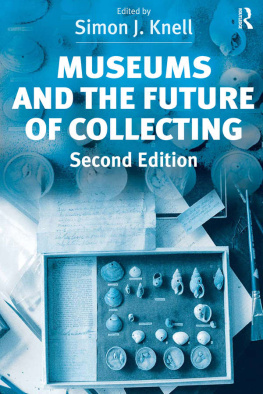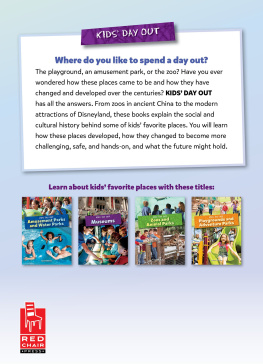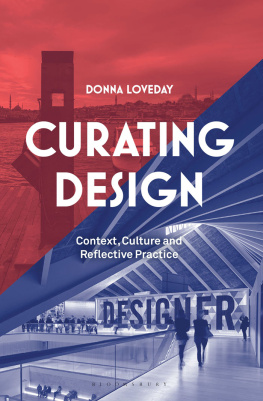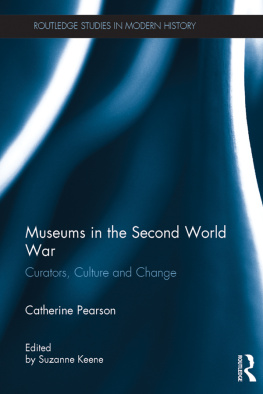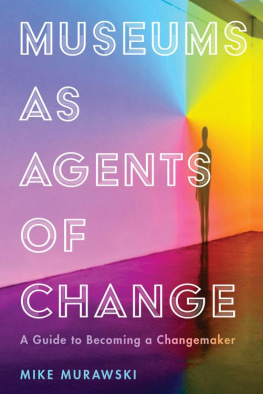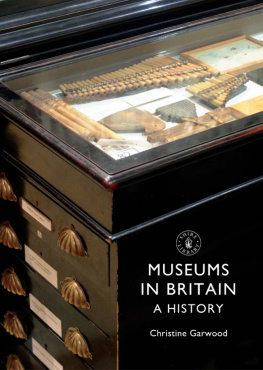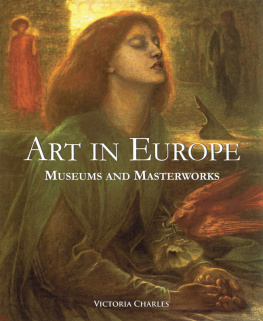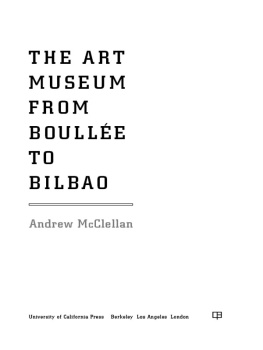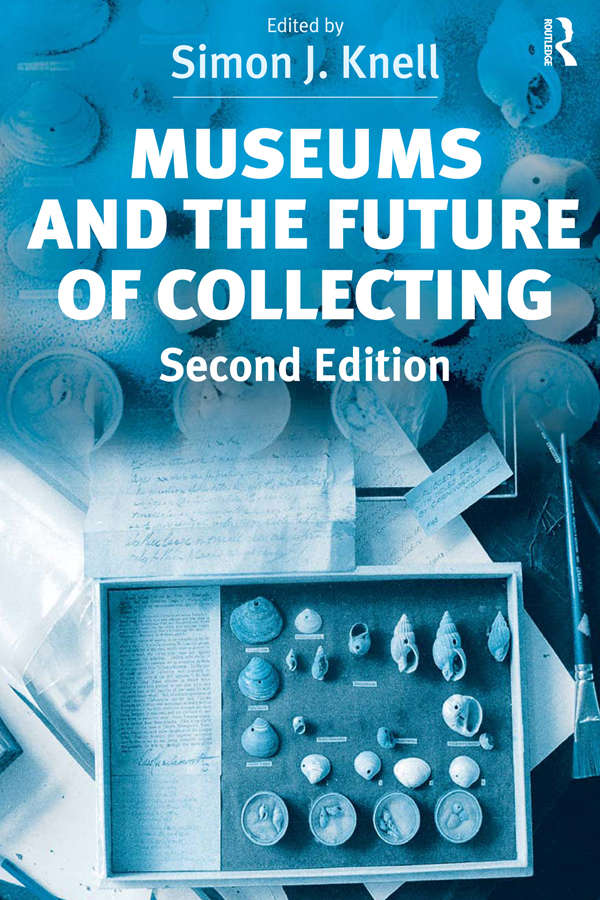
MUSEUMS AND THE FUTURE OF COLLECTING
Museums and the Future of Collecting
Second Edition
Edited by
SIMON J. KNELL
Department of Museum Studies
University of Leicester

First published 2004 by Ashgate Publishing
Published 2016 by Routledge
2 Park Square, Milton Park, Abingdon, Oxon OX14 4RN
711 Third Avenue, New York, NY 10017, USA
Routledge is an imprint of the Taylor & Francis Group, an informa business
Copyright 2004 by Simon Knell.
First edition 1999
Second edition 2004
All rights reserved. No part of this book may be reprinted or reproduced or utilised in any form or by any electronic, mechanical, or other means, now known or hereafter invented, including photocopying and recording, or in any information storage or retrieval system, without permission in writing from the publishers.
Notice:
Product or corporate names may be trademarks or registered trademarks, and are used only for identification and explanation without intent to infringe.
British Library Cataloguing in Publication Data
Museums and the Future of Collecting
1. Museums Collection management. I. Knell, Simon J.
069.5
US Library of Congress Cataloging in Publication Data
Museums and the Future of Collecting / edited by Simon J. Knell.
p. cm. Papers originally presented at a conference organised by the Department of Museum Studies at the University of Leicester. Includes bibliographical references and index.
1. Museums Acquisitions Congresses. I. Knell, Simon J.
| AM135.M864 1999 | 98-46336 |
| 069.51dc21 | CIP |
ISBN 9780754630050 (pbk)
Contents
Simon Knell, Department of Museum Studies, University of Leicester, England
Susan Pearce, Department of Museum Studies, University of Leicester, England
Malcolm McLeod, Hunterian Museum and Art Gallery, University of Glasgow, Scotland
Richard Dunn, Department of Exhibitions and Design, British Museum, London, England
Patricia Kell, Parks Canada
Rebecca Duclos, Centre for Museology, University of Manchester, England
Barbara Lawson, Redpath Museum, McGill University, Montreal, Canada
Paul Martin, Department of Museum Studies, University of Leicester, England
Gaynor Kavanagh, Faculty of Media and Culture, Falmouth College of Arts, England
arka Vujic, Department of Museology, University of Zagreb, Croatia
Graham Dominy, National Archives and Records Service of South Africa
Nicola Clayton, Department of Museum Studies, University of Leicester, England
John Martin, HaleySharpe Design, Leicester, England
Michael Taylor, National Museums of Scotland, Edinburgh, Scotland
Janet Owen, National Maritime Museum, London, England
Linda Young, Cultural Heritage Management, University of Canberra, Australia
Anna Steen, Samdoksecretariat, Nordiska Museet, Stockholm, Sweden
Barbro Bursell, Livrustkammaren, Stockholm, Sweden
Mara Garca, Carmen Chinea and Jos Farina, Organismo Autnomo de Museos y Centros, Tenerife, Spain
Jean-Marc Gagnon and Gerald Fitzgerald, Canadian Museum of Nature, Ottawa, Canada
Martin Wickham, Chartered Mechanical Engineer, and formerly Keeper of the Vehicle Collection, Tank Museum, Bovington, England
Patricia Ainslie, Glenbow Museum, Calgary, Canada
James Fowler, The Theatre Museum, London, England
Tomislav Sola, Department ofMuseology, University of Zagreb, Croatia
The contributions to this book review collecting practices in museums and suggest future directions. First published in 1999, in response to an international conference held in Leicester entitled Carry on Collecting?, the perspectives here come from museum practitioners and scholars of museums. They deal with such varied topics as the international trade in fossils, the representation of subcultures, policies for the small museum, connoisseurship, inferences from collecting studies and histories, disciplinarity, nationhood, collaborative methodologies and so on. It is a kaleidoscopic collection.
In this second edition I have made a number of significant improvements: the whole book has been reformatted, original illustrations added, subheads have been restored, notes now appear at the foot of the page, and I have produced a new index. I have also made some additions to the text: Rebecca Ducloss paper has had some content restored, I have added an innovative paper on ranking collections by Martin Wickham and a substantial new introductory chapter of my own.
Since first publishing this book, I have been fortunate enough to travel to many parts of the world talking about collections and collecting. This has given me the opportunity to talk to many academics, practitioners and students, from whom I have learned much. I have also taken over material culture teaching from my colleague Susan Pearce and produced, amongst other things, a substantial book on the simultaneous origins of provincial museums and geology in England in the early nineteenth century, which is based on a study of collecting practices, and a similar study of science and collecting culture in the late twentieth century. The chapter I have written here reflects all these experiences and, rather provocatively and like all the chapters in this book, is particularly aimed at informing future practice.
Finally, I should note that a great many contributors have moved post in the few years since the first edition, and I have not been able to contact everyone directly. I thank them again, and hope that the surprise of finding their work in paperback will be a pleasant one!
Simon J. Knell
Department of Museums Studies, University of Leicester
March 2003
Simon Knell
The collecting problem facing museums has many facets. Many believe it is simply a matter of locating an answer to the questions What and how should a museum collect? But the problem is also one of aspirations and implications: unsatisfied desires mingle with full stores and overcommitted budgets. And while it is possible to locate many aspects of museum context and provision that explain why museums are never entirely successful collectors, and about which museums have much to complain, those of us who undertake the collecting also cherish beliefs, philosophies and practices which contribute to our undoing. We also undertake our collecting in a changing world and it this changing world which both provides the motivation to collect and yet, as I shall explain, also questions its validity.
Were our ancestors here now, they would have no difficulty recognising this modem collecting problem, for they too had faced it, often within a few years of the establishment of their institutions. But when they began the modem phase of institutional collecting, almost two centuries ago, they felt they were, in many ways, dealing with a finite world. They were primarily collecting objects from nature, in a world designed by a God, where the meaning of the object was set almost unquestioningly in the context of scientific realism. Indeed, within 50 years, some felt they had achieved their primary collecting goal. What they did not foresee, initially, was that collecting would continue as knowledge, education, entertainment, social politics, fashion and so on demanded, and as the museums disciplinary interests diversified. Cultural change thus added to the diversity of collectables while the emergence of a pervasive museum culture instilled in society a new need for public giving. Any finitude in the collecting project was surely an illusion.
Next page
